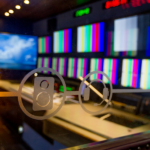Panasonic: Education on demand

Posted on May 8, 2023 by FEED Staff
Sponsored editorial
Learning is now intimately bound with digital technology. Panasonic’s glass-to-glass solutions are helping institutions future-proof their teaching
The concept of education is an ever-changing model. From content, to the ways in which we deliver it, we live in a continuous cycle of relearning how to teach.
It was long before the events of 2020 that education started to redefine itself once again – this time into the hybrid and digitised hub of knowledge that we see today. The transformation was made unavoidable by a move to remote education during the pandemic, where students and educators had no choice but to teach and consume materials from home.
Panasonic Broadcast & ProAV had already been implementing AV workflows and solutions to academic institutions for more than a decade.
“For some years, we’ve been delivering to a growing global demand to find the perfect solution for lecture capture and online or hybrid learning,” says business development manager for higher education at Panasonic Connect Europe, Hilmar Salac.
“Our glass-to-glass approach, from the live recording, video management system (Panopto), the production process, to the projector displaying the image, covers the full workflow. This approach makes our solution popular with small- to large-scale educational environments.”
Finding a solution
Panasonic’s glass-to-glass solution covers everything from the PTZ cameras capturing lectures and seminars to displays and projectors. That includes the integrated software that works behind the hardware.
“We work with various different companies that all contribute to our overall solution – such as Panopto,” explains Salac.
“From video placement storage to automated movement and audio tracking, Panasonic makes sure the process is as seamless and automated as possible, meaning there’s no need for an operator in
the lecture hall.”
Panopto is a tool which allows anyone to record lectures – and other video content – and simultaneously upload them to databases such as Blackboard; letting students view them asynchronously.
Panasonic approaches all new academic projects as custom-tailored solutions – this is due to universities, schools and higher education varying drastically in terms of size, budget and particular needs.
Let’s get Digital
Sciences Po is an internationally acclaimed university in France. Ranked third after Harvard and
Oxford for political science, it was integral that staff and students had a reliable remote workflow set-up, due largely to its student population spanning over 150 countries, which presented issues such as variation in time zones, signal qualities, data privacy and internet access.
When Covid-19 hit, Sciences Po leveraged its already-substantial history of digital teaching, with several classes and events having been documented with the help of Panasonic for some time.
“In this case, the broadcasting of lectures and seminars was already in place. However, due to the pandemic, this needed to be accelerated, rather than continuing the slow transition trajectory,” emphasises product marketing manager of Panasonic Connect Europe, Anna Arkatova. “Sciences Po was extremely confident to choose Panasonic for the next step, due to its existing reliance of our PTZ and studio cameras.”
The university team decided it was time to develop the idea of a ‘second campus’, enabling the option for students to study either fully on-site, purely online or a hybrid mixture. This team only had the summer of 2020 to complete the project, and knew Panasonic’s solutions would allow for a fast evolution. During a crucial entry period into its physical-to-digital transition, Panasonic’s experience and scalability proved the best choice.
“Then came Kairos, the latest technological advancement that meant they now not only had a switcher, but something that could manage the full solution, including presentations. This was a no-brainer. They could see the lack of manpower required – instead just having one person managing several tasks at once due to its reliability as a system,” says Arkatova.
With a fleet of 50 Panasonic cameras, the Sciences Po campus is fully running on one system. This means if a technician from Paris goes to a regional campus, they will be able to find identical tools – and software – and will know precisely how to use the system.
“What we learnt from this use case was that universities aren’t only about educating, but are becoming a hub of different activities,” adds Arkatova.
“They have the possibility of blended learning, as well as a studio that is ready for large-scale political live events that take place there.
“Additionally, there is another layer of corporate and internal board meetings, all set up with video – and processing systems to provide a remote option if needed.”
Plug and play
In 2021, the University of Kassel celebrated its 50th anniversary. With 25,000 students at five locations, the need arose to future-proof. The project consisted of upgrading 26 lecture halls with Panasonic PTZ cameras, projectors and professional video management systems.
The digitisation of Kassel originally began over four years ago, at which time the digital education team explored all avenues on offer in the broadcast field to determine the best solution for Kassel’s needs.
“We were part of the journey from start to finish,” highlights Salac. “First there was a successful evaluation and testing phase. Then, within two weeks of the Covid-19 crisis starting, we had fully upgraded 26 rooms with over 50 of our cameras and software. Just from those two weeks alone, over 2000 professors were able to teach more than 23,000 students.”
The simple plug-and-play dynamic of Panasonic’s solutions was a central selling point for the Kassel team, allowing for a quick set-up process and conclusively establishing itself in just two weeks.
Once again, the benefit of Panasonic’s work with Panopto allowed the University of Kassel team to quickly centralise the admin infrastructure. The next step for the university was the implementation
of Panasonic’s auto-tracking software, to fine-tune the broadcast quality of its content.
“Seeing is believing. So we either bring people to us, or go to them with all our hardware and build an entire studio, just to help them see, learn and understand what we offer. I think the record was when we brought over 100kg of cameras and equipment,” recalls Salac.
It’s evident that Panasonic’s glass-to-glass approach goes above and beyond, from the physical hardware to delivering an unbreakable digital knowledge hub like no other.
“We have seen universities leveraging our offerings to deliver education in over 20 languages at a time – meaning after a lesson you can watch it again straight away with subtitles in English, French, Spanish, Chinese – the list goes on.
“On top of that, everything is searchable. Every single word spoken by the lecturer, every document mentioned, every word written on the digital whiteboard can be searched for – contributing to this greater knowledge database.
“Overall, it’s a simple and sophisticated concept. Our solution is sustainable, scalable and entirely future-proof,” Salac concludes.
To learn more, head to business.panasonic.co.uk
Originally published in the spring 2023 issue of FEED magazine.










